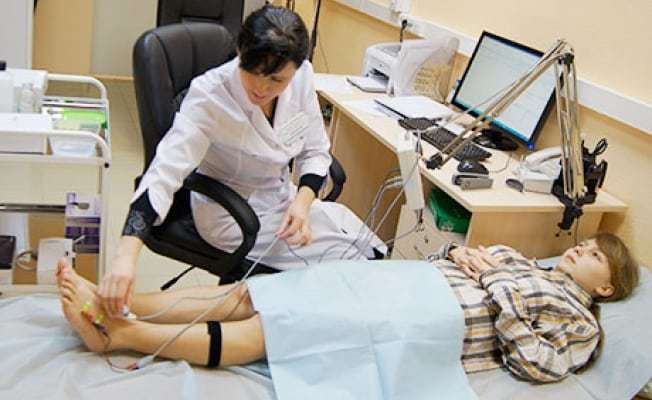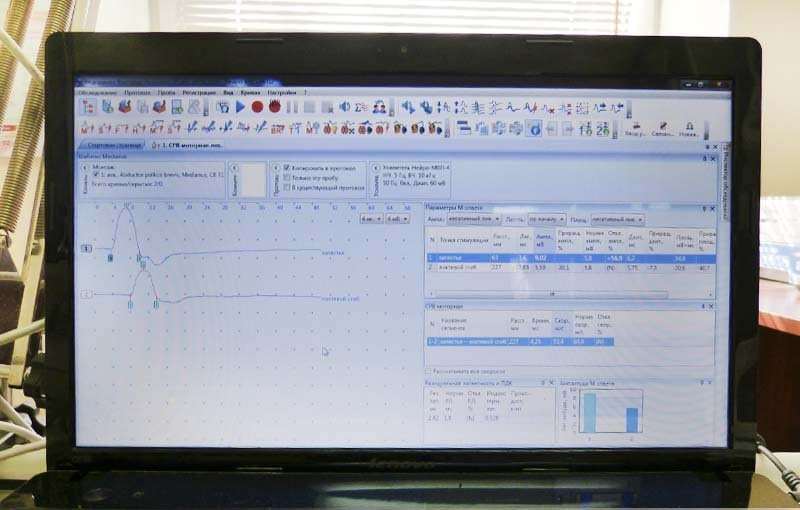ENMG: what is it and how is electromyographic research done
Electroneuromyography is a method of instrumental diagnostics with the help of which the contractility of muscle fibers and the state of functioning of the nervous system are determined.
With the help of electroneuromyography, differential diagnostics is carried out not only for organic and functional pathologies of the nervous system, but it is widely used in surgical, ophthalmic, obstetric and urological practice.
Content
- There are two methods of conducting this research:
- What is the purpose of electroneuromyography?
- Research methods
- Medical indications for diagnostics
- In what cases is the diagnosis contraindicated?
- How to correctly interpret the obtained research results?
- Related Videos
There are two methods of conducting this research:
Neuromyography - this technique is performed using a special apparatus that registers the action potential from the muscle fiber in the phase of increased muscle activity. Action potential what it is is a unit of measurement of the strength of a nerve impulse conduction from a nerve to a muscle.
As a rule, each muscle has its own borderline action potential, this is due to its strength and localization in the human body. In view of the difference in potentials in different muscle groups, after registration of all potentials, they are summed up.
Electroneurography is performed using an apparatus that records the speed of movement of a nerve impulse to tissues.
What is the purpose of electroneuromyography?

The human body is able to function only due to the functioning of the nervous system, which is responsible for motor and sensory function.
The nervous system is subdivided into peripheral and central. All reflexes and movements that a person performs are controlled by the central nervous system.
With the pathology of any specific link in the nervous system, transmission is disturbed impulses along the nerve fiber to muscle tissues, and as a result, a violation of their contractile activities.
The essence of the technique is to register these impulses and determine the violation in one or another link of the nervous system.
When a nerve is irritated, the contractility of individual muscle groups is recorded, and on the contrary, when muscles are excited, the ability of the nervous system to react in response to irritation.
Read also:Cephalgic syndrome (cephalalgia): what it is, causes, symptoms and treatment
The study of the functional ability of the cerebral cortex is carried out by irritation of the analyzers of auditory, visual and tactile sensitivity. The reaction of the central nervous system is recorded on the apparatus.
ENMG is one of the most informative methods for diagnosing diseases associated with paresis or paralysis of the extremities, as well as diseases of the muscular skeleton and articular apparatus of the human body. With the help of electroneuromyography, diagnostics is carried out at the first stages of the development of pathology, which contributes to the timely implementation of therapeutic measures.
According to the results of the study, it is possible to judge from how the impulse passes along the nerve endings, and where the violation occurred in the nerve fiber.
After the diagnosis, it is possible to determine such characteristics of the lesion as:
- locality of the lesion focus (systemic or focal pathology);
- pathogenetic characteristics of the development of the disease;
- the mechanism of action of the etiological factor of pathology;
- how widespread is the focus of the disease;
- to assess the degree of damage to the nerve and muscle fibers;
- the stage of the disease;
- dynamic change in nervous and contractile activity.
Also, ENMG allows you to monitor changes in the patient's condition during treatment and the effectiveness of certain methods of therapy. Using this diagnostic method, you can monitor the state of the central and peripheral nervous system, and the muscular apparatus.
Research methods
There are three ways to diagnose:
- Superficial - electrodes for recording impulses are installed on the skin, above the muscle under study. The peculiarity of the technique is that it is carried out without artificial stimulation of the nerve, with physiological functioning.
- Needle method refers to the category of invasive interventions in which needle electrodes are inserted into the muscle to record the intensity of its irritation.
- Method using nerve fiber stimulation, is, as it were, mixed, since for this purpose, cutaneous and needle-type electrodes are used simultaneously. The difference between this method is that for the diagnosis it is necessary to stimulate the nerves and muscles.
Read also:Trigeminal neuralgia: symptoms and treatment
Medical indications for diagnostics

Diagnosing a disease using electromyography is indicated for diseases such as:
- Sciatica is a neurological disease that develops as a result of a violation integrity or compression of the motor and sensory roots of the spinal cord by deformed bodies vertebrae.
- Syndrome of compression of a nerve by bones or muscle tendons.
- Hereditary or congenital disorders in the structure and function of nerve fibers, traumatic soft tissue injuries, chronic connective tissue diseases and diabetes.
- Diseases that are associated with the destruction of the myelin sheath of the nerve.
- Oncological formations in the parts of the spinal cord and brain.
In addition to the above diseases, neuromyography can also be performed with the following symptoms:
- feeling of numbness in the limbs;
- painful sensations during physical activity.
- increased fatigue in the limbs;
- ulcers formation on the skin;
- hypersensitivity to tactile stimuli;
- deformed changes in the bone and articular system;
In what cases is the diagnosis contraindicated?
Neuromyography is contraindicated in case of excessive overexcitation of nervous activity and in diseases associated with cardiovascular pathology.
Neuromyography is absolutely contraindicated in case of epileptic activity of the brain; stimulation of the nervous tissue can provoke the development of another attack.
Before starting the diagnostic procedure, you should pay the attention of the attending doctor to the features of your anamnesis, it may be associated with the presence of prostheses or pacemakers, with chronic illness, mental illness, or early pregnancy gestation.
When preparing for the study, it is necessary in 3-4 hours do not drink strong tea, alcoholic substances, do not take stimulating medications.
The duration of the diagnosis is approximately 60 -70 minutes, depending on the method of recording electrical impulses. Superficial and needle type examination is more informative if the patient is in a supine state.
Electrodes are inserted on the surface of the skin or inside the muscle and the indicators are recorded.
Read also:Why is the disease of a retrocerebellar arachnoid cyst of the brain dangerous?
The recumbent position is preferable because the apparatus does not register additional impulses from muscle fibers. After carrying out the diagnostic technique, the patient may feel some discomfort and numbness.
How to correctly interpret the obtained research results?

Only a specially trained qualified specialist can evaluate and decipher the diagnostic indicators of neuromyography. When receiving the results, the doctor compares the obtained indicators with the norm, assesses the degree of deviations and establishes a preliminary diagnosis of a particular pathology.
For a visual assessment of changes in muscle and nervous activity, a special graphic image is formed. Changes in the graphic image can be individual and depend on the type of disease.
This diagnostic technique is carried out in specialized departments of functional diagnostics according to the recommendations of the attending doctor. The procedure is carried out several times when it is necessary to dynamically monitor the state of the human nervous and muscular system.
Incorrect conduct of the procedure can occur through such factors:
- the patient's unwillingness to fulfill certain requirements that are necessary for the diagnostic method;
- the presence of diseases that can affect the result of the study;
- improper placement of electrodes;
- the presence of objects under or near the electrodes that impede the conduction of an electrical impulse from the device;
- a history of mental illness.
All of the above problems in the diagnosis can provoke an incorrect diagnosis and affect the further treatment and recovery of the patient.



